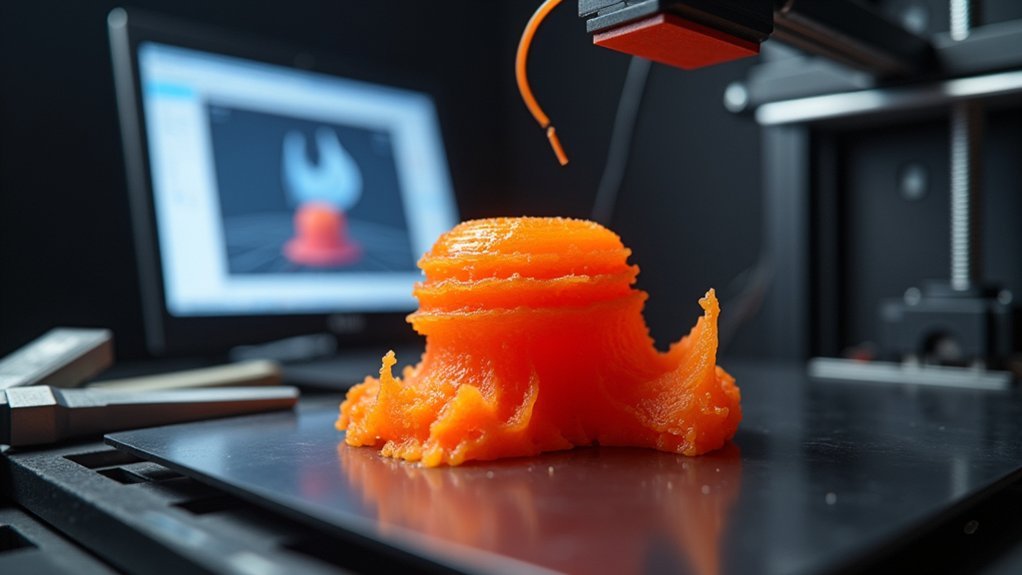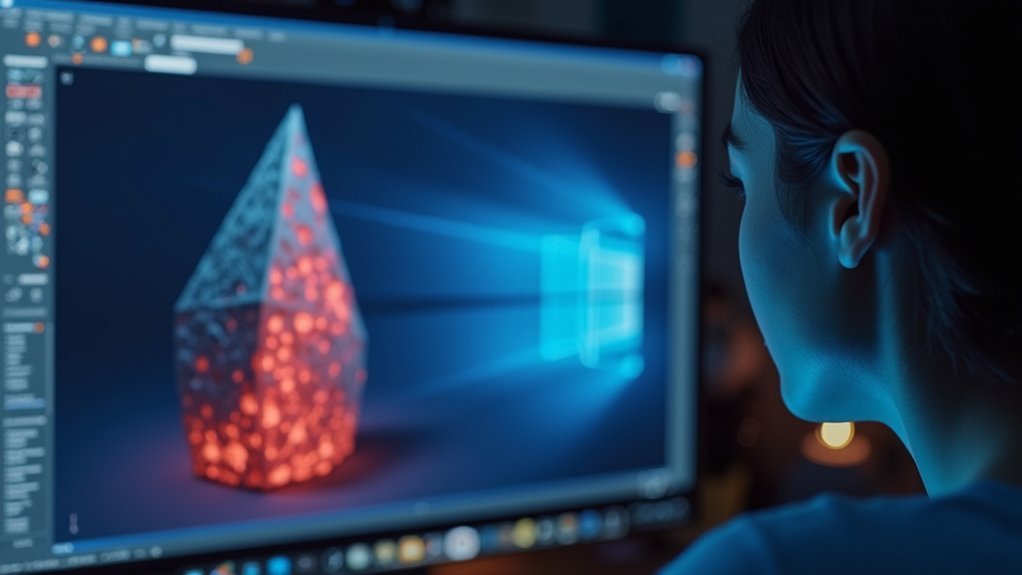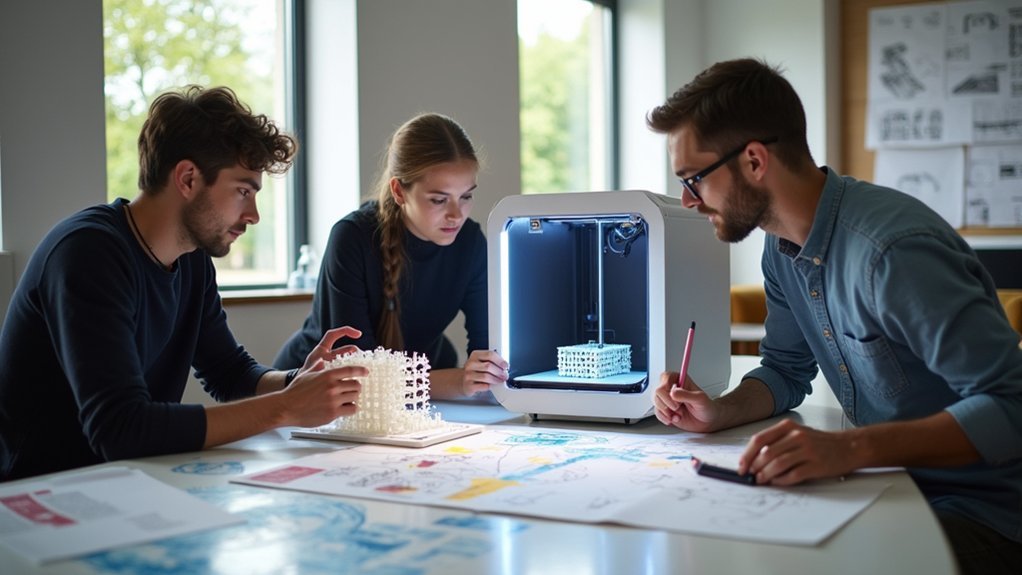You can repair inverted normals in STL files using free tools like Blender’s 3D Print Tool, which highlights problematic normals in red, or Netfabb Basic’s automated repair functions. In Blender, select all faces in Edit mode and use “Recalculate Outside” to fix orientation issues. Meshmixer and SketchUp’s Solid Inspector2 also detect and repair inverted normals effectively. Always validate your repairs using mesh analysis tools before exporting to guarantee your slicer software interprets surfaces correctly and produces successful prints.
What Are Normals and Why Do They Matter for 3D Printing

Normals are invisible vectors that extend perpendicular from each surface of your 3D model, pointing outward to define which side is the exterior face.
Think of them as arrows indicating what’s inside versus outside your object. When normals point correctly outward, your 3D printer understands which areas to fill with material and which to leave hollow.
However, inverted normals flip this orientation, pointing inward instead of outward. This confuses slicing software, potentially causing your printer to fill hollow spaces or leave solid areas empty.
Inverted normals confuse slicing software, causing printers to fill hollow spaces or leave solid areas empty.
You’ll face failed prints, wasted material, and costly reprints.
That’s why STL repair becomes essential before printing. Properly oriented normals guarantee your model prints exactly as intended, preventing expensive mistakes and ensuring successful results.
Common Symptoms of Inverted Normals in STL Files
You’ll notice inverted normals in your STL files when surfaces appear dark, transparent, or completely missing in your 3D modeling software’s viewport.
Your models might display strange shading artifacts where faces seem to flip between visible and invisible as you rotate the view.
Print services will often reject your files outright, citing geometry errors that prevent successful slicing and printing.
Visual Display Errors
Several telltale signs indicate when your STL file contains inverted normals that’ll disrupt the visual display.
You’ll notice faces appearing red or highlighted in most 3D modeling applications, signaling that interior surfaces are facing outward instead of inward. These inverted normals create visual artifacts like flickering surfaces, incorrect texture mapping, and transparency issues that make it nearly impossible to evaluate your model’s true geometry.
Your 3D printing software will often display warning messages or error notifications when detecting these problematic normals during file import or slicing preparation.
The model may appear to have holes or missing sections, even though the geometry is technically complete. Surface shading becomes inconsistent, with some areas appearing darker or lighter than expected, making quality assessment challenging before printing.
Print Service Rejections
Beyond causing visual problems in your modeling software, inverted normals will trigger automatic rejections from professional print services. Major platforms like Shapeways and iMaterialise specifically flag inverted normals as a primary reason for rejecting STL files.
When you upload files with this issue, you’ll receive error messages indicating “non-manifold geometry,” which signals surface integrity problems that prevent successful printing.
These rejections occur because inverted normals make your model appear to have holes or gaps when processed through slicer software. The print service’s automated checking systems can’t determine proper surface orientation, making your design unprintable.
This directly impacts your design’s printability and delays your project timeline. You’ll need to fix these orientation issues before resubmitting, or face continued rejections from professional printing services.
How Inverted Normals Affect Print Quality and Success

When inverted normals plague your 3D model, they’ll wreak havoc on your printing process by confusing slicer software about which surfaces represent the exterior and interior faces of your object.
This misinterpretation creates non-manifold edges and mesh holes, preventing successful 3D printing altogether. You’ll notice incomplete layers forming during the print, creating structural weaknesses that compromise your model’s integrity.
Even when your model appears perfect in design software, inverted normals cause invisible or incorrectly shaded areas that destroy the final print’s aesthetic quality.
Your slicer can’t generate proper toolpaths when it can’t distinguish between inside and outside surfaces. Without properly oriented normals creating a manifold mesh, you’ll face gaps and overlaps where edges should connect seamlessly between faces.
Best Free Software Tools for Detecting Inverted Normals
You’ll need reliable software to identify inverted normals before attempting repairs, and several free tools excel at this task.
Blender’s built-in 3D Print Tool add-on stands out as an excellent choice since it can analyze your STL files and highlight problematic areas with inverted normals and non-manifold edges.
Netfabb Basic also offers powerful analysis features that make detecting these mesh issues straightforward through its intuitive interface.
Blender’s 3D Print Tool
Among Blender’s most valuable features for 3D printing preparation, the integrated 3D Print Tool stands out as an all-encompassing solution for detecting inverted normals and other geometry issues.
You’ll find this essential add-on highlights reversed normals in red, making problematic faces immediately visible when analyzing your STL files.
To maximize this tool’s effectiveness:
- Enable the 3D Print Tool in Blender’s Add-ons preferences section
- Import your STL file and run the analysis to detect geometry problems
- Use Show Non-manifold feature to identify inverted normals highlighted in red
- Select affected faces and apply “Recalculate Normals” for manual correction
The tool generates detailed reports of detected issues, helping you understand specific problems requiring attention before printing.
Netfabb Analysis Features
Netfabb’s thorough analysis features make it one of the most reliable free tools for detecting inverted normals in your STL files. The software uses distinct coloration to highlight problematic areas, including non-manifold edges and intersecting faces that can disrupt printing. You’ll easily identify where normals point inward instead of creating one surface orientation.
| Feature | Function |
|---|---|
| Visual Highlighting | Colors inverted normals for easy identification |
| Non Manifold Detection | Identifies edges shared by multiple faces |
| Intersecting Faces Analysis | Locates overlapping geometry issues |
| Part Repair Tool | Automatically fixes mesh integrity problems |
You can manually inspect specific areas or use the automated “Part Repair” function to fix inverted normals instantly. Netfabb’s free version provides essential mesh analysis tools that’ll help guarantee your models are print-ready.
Using Blender’s 3D Print Tool to Identify and Fix Normal Issues

When preparing models for 3D printing, Blender’s integrated 3D Print Tool serves as your first line of defense against normal issues that can ruin your print.
This built-in add-on analyzes STL files for common printing problems, including inverted normals, non-manifold edges, and intersecting faces.
Here’s how to use it effectively:
- Activate the tool by guiding to Scene properties, enabling the add-on, then accessing it from the N panel under the “3D Print” tab.
- Identify problem areas where the tool highlights inverted normals in red for easy spotting.
- Fix the normals by selecting affected geometry and using “Shift + N” or Mesh > Normals > Recalculate Outside.
- Perform final analysis to confirm your model’s manifold and print-ready.
Repairing Inverted Normals in Meshmixer Step-by-Step
When you’re working with STL files that have inverted normals, Meshmixer offers a straightforward approach to identify and fix these issues.
You’ll start by opening your STL file in Meshmixer and using the Inspector tool to detect problematic faces that are pointing inward.
Once you’ve identified the inverted normals, you can either manually select and flip them or use the Auto Repair feature to correct the normal direction automatically.
Opening STL Files
First, you’ll need to get your STL file loaded into Meshmixer’s workspace. The process is straightforward and sets the foundation for identifying and fixing those problematic inverted normals that can cause printing issues.
Follow these steps to open your STL file:
- Launch Meshmixer – Start the application on your computer.
- Access the File menu – Click on “File” in the top menu bar.
- Select Import – Choose “Import” from the dropdown menu options.
- Navigate and select – Browse to your STL file location and click to select it.
Once you’ve completed these steps, your 3D model will appear in Meshmixer’s workspace, ready for analysis and repair.
You’ll see the mesh displayed in the main viewing area where you can rotate and examine it.
Detecting Inverted Normals
After loading your STL file into Meshmixer, you’ll need to identify where the normals are pointing in the wrong direction before you can fix them.
Navigate to the “Analysis” tool in the toolbar to begin the detection process. This powerful feature will scan your entire model and highlight problematic areas in red where normals are inverted. The visual feedback makes it easy to spot issues at a glance.
For a more thorough approach, you can use the “Inspector” tool, which automatically detects both inverted normals and non-manifold edges simultaneously. This saves time by identifying multiple problems in one scan.
Before proceeding with any repairs, save a backup of your original model since modifications can alter the geometry and potentially affect your design’s overall structure.
Fixing Normal Direction
Once you’ve identified the inverted normals through the detection process, you can begin correcting them using Meshmixer’s built-in repair tools.
The repair process involves several targeted steps to guarantee your model becomes print-ready.
Here’s how to fix the normal direction issues:
- Select problematic faces – Click on the red faces identified by the Inspector tool to highlight the areas with inverted normals.
- Flip the normals – Navigate to the Edit menu and choose the “Flip” option to correct the orientation of selected faces.
- Verify manifold geometry – Run the Inspector tool again to check for remaining holes or non-manifold edges that could affect printing.
- Apply Make Solid – Use this feature to create a watertight model, automatically resolving surface issues and guaranteeing proper normal orientation throughout.
SketchUp Solid Inspector2 for Automatic Normal Correction
When dealing with complex 3D models that contain multiple geometric errors, SketchUp’s Solid Inspector2 plugin offers an automated solution that’ll save you considerable time and effort.
This free tool automatically analyzes your model and identifies inverted normals alongside other critical issues like non-manifold edges and holes. You’ll see problematic areas highlighted, making it easy to understand what needs fixing.
The plugin works across various SketchUp versions, ensuring accessibility regardless of your software setup.
Once you run Solid Inspector2, it’ll guide you through correcting each issue systematically. This thorough approach means you’re not just fixing normals—you’re ensuring your entire model meets 3D printing standards.
Solid Inspector2 systematically guides you through fixing each issue, ensuring your entire model meets professional 3D printing standards.
The automated process lets you focus on creative design rather than technical troubleshooting.
Netfabb’s Approach to Normal Analysis and Repair
While SketchUp’s Solid Inspector2 excels at identifying multiple geometric issues simultaneously, Netfabb takes a more specialized approach by focusing specifically on STL file analysis and repair.
You’ll find Netfabb’s tools particularly effective for visualizing and correcting inverted normals in your 3D models.
Here’s how you can leverage Netfabb’s capabilities:
- Use automated repair functions to quickly recalculate normal directions and confirm they face outward properly.
- Access the Part Repair feature for manual inspection and detailed control over mesh geometry modifications.
- Identify non-manifold edges and related mesh errors that often cause inverted normals.
- Optimize mesh integrity to confirm your repaired models are print-ready and error-free.
Netfabb’s thorough approach reduces printing failures considerably.
Manual Normal Flipping Techniques in Popular 3D Software
Several popular 3D modeling applications offer straightforward manual methods for correcting inverted normals when automated repair tools aren’t sufficient.
Manual normal correction methods in popular 3D software provide essential backup solutions when automatic repair algorithms fail to properly orient surface geometry.
In Blender, you’ll select the problematic faces, press ‘Alt + N’, and choose ‘Flip’ to manually reverse inverted normals for selected geometry.
Fusion 360 users can utilize Surface/Patch tools to select the surface body and reverse incorrectly oriented normals.
SketchUp provides a simple solution—right-click on a face and select ‘Reverse Faces’ to flip the orientation.
Meshmixer allows you to select your object, navigate to the ‘Edit’ menu, and choose ‘Reverse Normals’ for mesh correction.
Netfabb enables manual adjustments through its ‘Repair’ tool, letting you visualize and fix inverted normals to guarantee all normals face outward properly.
Preventing Normal Inversion During Model Export
Although flipping normals after export can fix orientation issues, you’ll save significant time by preventing normal inversion from occurring in the first place.
Taking preventive measures during the modeling and export process eliminates the need for post-export repairs.
Follow these essential steps to maintain proper normal orientation:
- Create manifold geometry – Guarantee all edges are shared by exactly two faces to prevent structural inconsistencies that lead to normal confusion.
- Configure export settings properly – Select STL format with “export normals” enabled in your modeling software to preserve orientation data.
- Validate before exporting – Use mesh analysis tools like Netfabb or Blender’s 3D Print Tool to identify and correct inverted normals beforehand.
- Simplify complex models – Remove unnecessary internal structures that can cause normal inversion during export processing.
Verifying Normal Repairs Before Sending to Print Services
After implementing preventive measures and repairing any inverted normals, you must verify your model’s integrity before submitting it to print services.
Use Blender’s 3D Print Tool to analyze your STL file for inverted normals and mesh issues that could cause print failures. Check visually for non-manifold edges and inverted normals, as these defects lead to rejected prints and wasted resources.
Blender’s 3D Print Tool identifies critical mesh defects and inverted normals that cause expensive print failures and service rejections.
If you discover problems, utilize Netfabb or Meshmixer to automatically fix inverted normals and generate a proper manifold mesh where every edge connects exactly two faces.
After repairs, inspect your model from multiple angles using tools that highlight problematic geometry.
Finally, export a test STL file and reimport it into your modeling software to confirm all normals are correctly oriented before sending to print services.
Understanding Surface Bodies and Hidden Elements That Cause Normal Problems
While your model may appear perfect on screen, hidden surface bodies and invisible elements often lurk beneath the surface, causing inverted normals that’ll sabotage your 3D prints.
These unintentional components create chaos when you export to STL format, generating face orientation problems that make models unprintable.
Surface bodies aren’t solid volumes—they’re thin shells that confuse 3D printing software. When mixed with solid bodies, they create conflicting normal directions that’ll ruin your print job.
Here’s how to identify and eliminate these problematic elements:
- Enable all visibility settings in your modeling software to reveal hidden components
- Check for surface and patch bodies in your design tree or browser
- Remove or convert surface bodies to proper solid geometry
- Inspect model structure before STL export to guarantee manifold geometry
Frequently Asked Questions
How to Fix Reversed Normals?
You’ll identify reversed normals using software like Blender or Netfabb. In Blender, select affected faces and press ‘Shift + N’ to recalculate normals. Guarantee your model’s manifold for proper orientation.
How Do I Flip an STL File?
You can flip an STL file using Meshmixer’s “Flip Normals” function, Blender’s Alt+N shortcut in Edit Mode, or Fusion 360’s “Reverse Normal” option after selecting surfaces.
How to Reshape STL Files?
You’ll reshape STL files using software like Blender or Meshmixer. Use sculpting tools, Boolean operations, and solidify functions to modify geometry. Make certain you’re maintaining closed volumes and fixing mesh issues before exporting your reshaped model.
Can Blender Repair STL Files?
Yes, you can repair STL files in Blender. You’ll import the file, use Edit Mode to fix mesh issues, recalculate normals, and export the corrected model for 3D printing.





Leave a Reply